Even though Mesa handed the new Ley de Hidrocarburos (which includes many of the changes the COB demanded) to Congress — and published in full text in every newspaper yesterday — the COB (Central Obrera Boliviana) marched. And although Solares pointed out that their numbers were lower than in the Juan Lechín heydey of the 1950s-70s, I estimated the total number of marchers between 1,800-2,000. This included some hundred of from the COB, several hundred gremialistas, and at least a hundred of the students on strike demanding admittance to the university despite flunking the entrance exam. I managed various pictures, having seen the pre-march speeches & the march itself. Click on images to see larger version.
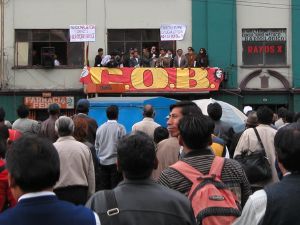
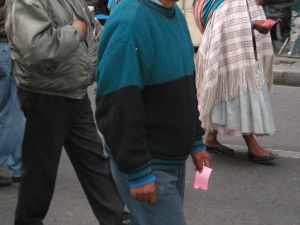
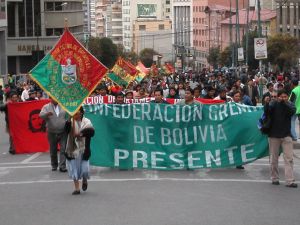
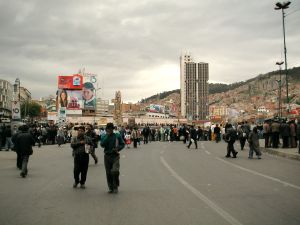
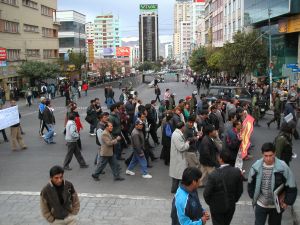
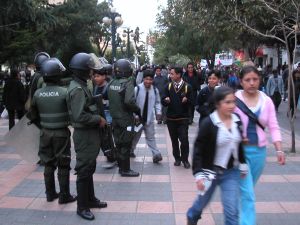
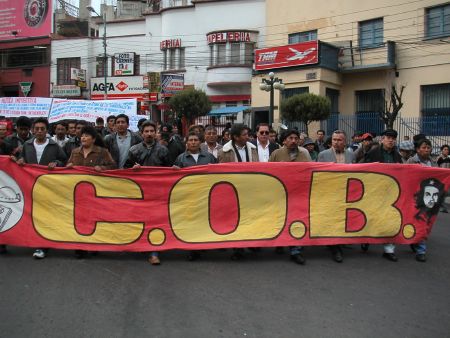
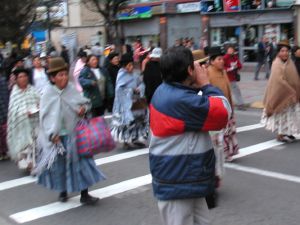
Jaime Solares gave a lengthy speech, filled w/ diatribes against the IMF, the US, Mesa, and transnational corporations in the most aggressive language. He even took time to point that many of the COB's regional branches are breaking away from the radical central leadership. Solares proposed that "we must hang those yellow dirigentes from the lampposts!" Lacking from the discourse was a proposal for what an alternative government policy should be.
The crowd gathered around Plaza San Francisco & Plaza de Heroes (the two are next to each other) was dwarfed by passersby & curious onlookers, many who stopped to complain about the situation. One elderly woman told me Juan Lechín (the COB's founder) must be rolling in his grave to see what Solares has done to the once-prestigious COB.
The march started w/ a barrage of smalldinamitas (powerful bottle rockets) launched into the air. This is common in marches, and they're sometimes launched into office windows or into crowds for fear factor. At least this time there was some police presence to keep things civil — unlike two weeks ago when a few hundred cobistas began attacking pedestrians.
The most interesting marchers are always the gremialistas. This is almost like a mafia in Bolivia. While the regimen simplificado tax code which makes gremialistas possible — they're the informal commercial sector, legally exempt from taxes & other bureaucratic oversight — is meant for small, poor street entrepreneurs, many gremialistas comprise the chola elite (mega rich). They keep their bases in line during marches. The gremialista marchers are marked by lines of cholitas led by well-dressed men (often carrying attaché cases) who shout instructions as they march.
Halfway through the march, I managed to take pictures of the famous fichas. Many marchers are paid as much as Bs.100 (about $12.50) a day to march; usually marchers disperse shortly after receiving their fichas (which prove they participated). The marchers did a single loop around the Prado, then back to San Francisco, then off to their homes. Traffic downtown was disrupted for about an hour.
-----
NOTE: In the Bolivian context, the accusation "yellow" doesn't mean "coward" (like in American English). It means "ambivalent opportunist". The phrase was used in 1952 when the MNR accused parties that didn't actively support the revolution in the early days as "amarillos."
" Mesa, w/ pants on? | Miguel Centellas
" Inexplicable | Randy Paul
" Good News in Colombia? | Randy Paul
" The current situation | Miguel Centellas
" Mesa's Sorata? | Miguel Centellas
" Bolivia news roundup | Miguel Centellas
" More Negative Exile Community Reaction to Bush's New Cuba Policy | Randy Paul
" Another AUC Figure Assassinated | Randy Paul
" I Think I'm Going to Open Up a Bottle of Concha Y Toro | Randy Paul
" Reagan, desde América Latina | David Holiday
" Matchday #7 | Eduardo Avila
" Matchday #6 | Eduardo Avila
" Bolivia's Worst Ambassador | Eduardo Avila
" more from living in latin america...
" living in india
" economy matters
" living in latin america
" china review
" bonobo land
" boulevard st michel
" bradf.com